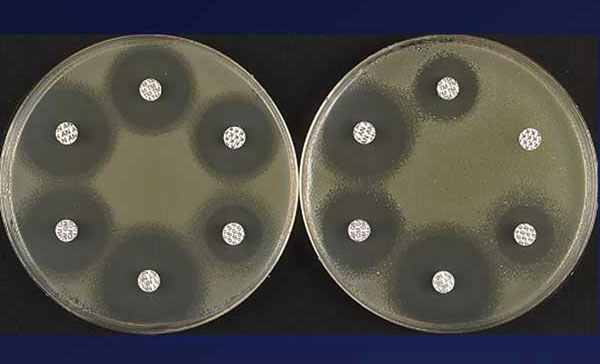Volume 11, Number 10—October 2005
Perspective
Antimicrobial Drug Resistance: "Prediction Is Very Difficult, Especially about the Future"1
Figure 2

Figure 2. Disk susceptibility test results of Escherichia coli BM694 (left) and of strain BM694 harboring plasmid pAT346, which confers tobramycin resistance by trapping (right) (27).
References
- Courvalin P, Trieu-Cuot P. Minimizing potential resistance: the molecular view. Clin Infect Dis. 2001;33:S138–46. DOIPubMedGoogle Scholar
- Seppala H, Klaukka T, Lehtonen R, Nenonen E, Huovinen P. Outpatient use of erythromycin: link to increased erythromycin resistance in group A streptococci. Clin Infect Dis. 1995;21:1378–85. DOIPubMedGoogle Scholar
- Andersson DI. Persistence of antibiotic resistant bacteria. Curr Opin Microbiol. 2003;6:452–6. DOIPubMedGoogle Scholar
- Chiew YF, Yeo SF, Hall LM, Livermore DM. Can susceptibility to an antimicrobial be restored by halting its use? The case of streptomycin versus Enterobacteriaceae. J Antimicrob Chemother. 1998;41:247–51. DOIPubMedGoogle Scholar
- Macrina FL, Archer GL. Conjugation and broad host range plasmids in streptococci and staphylococci. In: Clewell DB, editor. Bacterial conjugation. New York, London: Plenun Press; 1993. p. 313–29.
- Charpentier E, Courvalin P. Antibiotic resistance in Listeria spp. Antimicrob Agents Chemother. 1999;43:2103–8.PubMedGoogle Scholar
- Mazodier P, Davies J. Gene transfer between distantly related bacteria. Annu Rev Genet. 1991;25:147–74. DOIPubMedGoogle Scholar
- Walker MS, Walker JB. Streptomycin biosynthesis and metabolism. J Biol Chem. 1970;245:6683–9.PubMedGoogle Scholar
- Weigel LM, Clewell DB, Gill SR, Clark NC, McDougal LK, Flannagan SE, Genetic analysis of a high-level vancomycin-resistant isolate of Staphylococcus aureus. Science. 2003;302:1569–71. DOIPubMedGoogle Scholar
- Moubareck C, Bourgeois N, Courvalin P, Doucet-Populaire F. Multiple antibiotic resistance gene transfer from animal to human enterococci in the digestive tract of gnotobiotic mice. Antimicrob Agents Chemother. 2003;47:2993–6. DOIPubMedGoogle Scholar
- Taddei F, Matic I, Godelle B, Radman M. To be a mutator, or how pathogenic and commensal bacteria can evolve rapidly. Trends Microbiol. 1997;5:427–8. DOIPubMedGoogle Scholar
- Petrosino J, Cantu C III, Palzkill T. β-lactamases: protein evolution in real time. Trends Microbiol. 1998;6:323–7. DOIPubMedGoogle Scholar
- Chen ST, Clowes RC. Variations between the nucleotide sequences of Tn1, Tn2, and Tn3 and expression of β-lactamase in Pseudomonas aeruginosa and Escherichia coli. J Bacteriol. 1987;169:913–6.PubMedGoogle Scholar
- Baptista M, Depardieu F, Reynolds P, Courvalin P, Arthur M. Mutations leading to increased levels of resistance to glycopeptide antibiotics in VanB-type enterococci. Mol Microbiol. 1997;25:93–105. DOIPubMedGoogle Scholar
- Goussard S, Sougakoff W, Mabilat C, Bauernfeind A, Courvalin P. An IS1-like element is responsible for high-level synthesis of extended-spectrum β-lactamase TEM-6 in Enterobacteriaceae. J Gen Microbiol. 1991;137:2681–7.PubMedGoogle Scholar
- Rudant E, Courvalin P, Lambert T. Characterization of IS18, an element capable of activating the silent aac(6´)-Ij gene of Acinetobacter sp. 13 strain BM2716 by transposition. Antimicrob Agents Chemother. 1998;42:2759–61.PubMedGoogle Scholar
- Magnet S, Courvalin P, Lambert T. Activation of the cryptic aac(6´)-Iy aminoglycoside resistance gene of Salmonella by a chromosomal deletion generating a transcriptional fusion. J Bacteriol. 1999;181:6650–5.PubMedGoogle Scholar
- Leclercq R, Courvalin P. Resistance to macrolides and related antibiotics in Streptococcus pneumoniae. Antimicrob Agents Chemother. 2002;46:2727–34. DOIPubMedGoogle Scholar
- Courvalin P. Genotypic approach to the study of bacterial resistance to antibiotics. Antimicrob Agents Chemother. 1991;35:1019–23.PubMedGoogle Scholar
- Ferrandiz MJ, Fenoll A, Liñares J, de la Campa AG. Horizontal transfer of parC and gyrA in fluoroquinolone-resistant clinical isolates of Streptococcus pneumoniae. Antimicrob Agents Chemother. 2000;44:840–7. DOIPubMedGoogle Scholar
- Arthur M, Courvalin P. Contribution of two different mechanisms to erythromycin resistance in Escherichia coli. Antimicrob Agents Chemother. 1986;30:694–700.PubMedGoogle Scholar
- Ferretti JJ, Gilmore KS, Courvalin P. Nucleotide sequence analysis of the bifunctional 6´-aminoglycoside acetyltransferase, 2´´-aminoglycoside phosphotransferase determinant from Streptococcus faecalis: identification and cloning of gene regions specifying the two activities. J Bacteriol. 1986;167:631–8.PubMedGoogle Scholar
- Sougakoff W, Goussard S, Gerbaud G, Courvalin P. Plasmid-mediated resistance to third-generation cephalosporins caused by point-mutations in TEM-type penicillinase genes. Rev Infect Dis. 1988;10:879–84. DOIPubMedGoogle Scholar
- Mabilat C, Courvalin P. Development of "oligotyping" for characterization and molecular epidemiology of TEM β-lactamases in members of the family Enterobacteriaceae. Antimicrob Agents Chemother. 1990;34:2210–6.PubMedGoogle Scholar
- Nikaido H. Molecular basis of bacterial outer membrane permeability revisited. Microbiol Mol Biol Rev. 2003;67:593–656. DOIPubMedGoogle Scholar
- Li XZ, Nikaido H. Efflux-mediated drug resistance in bacteria. Drugs. 2004;64:159–204. DOIPubMedGoogle Scholar
- Ménard R, Molinas C, Arthur M, Duval J, Courvalin P, Leclercq R. Overproduction of 3´-aminoglycoside phosphotransferase type I confers resistance to tobramycin in Escherichia coli. Antimicrob Agents Chemother. 1993;37:78–83.PubMedGoogle Scholar
- Magnet S, Smith TA, Zheng R, Nordmann P, Blanchard JS. Aminoglycoside resistance resulting from tight drug binding to an altered aminoglycoside acetyltransferase. Antimicrob Agents Chemother. 2003;47:1577–83. DOIPubMedGoogle Scholar
- Srinivasan A, Dick JD, Perl TM. Vancomycin resistance in staphylococci. Clin Microbiol Rev. 2002;15:430–8. DOIPubMedGoogle Scholar
- Courvalin P. Transfer of antibiotic resistance genes between gram-positive and gram-negative bacteria. Antimicrob Agents Chemother. 1994;38:1447–51.PubMedGoogle Scholar
- Quintiliani R Jr, Sahm D, Courvalin P. Mechanisms of resistance to antimicrobial agents. In Murray PR, Baron EJ, Pfaller MA, Tenover FC, Yolken RH, editors. Manual of clinical microbiology. 7th ed. Washington: American Society for Microbiology; 1998. p. 1505–25.
- Pootoolal J, Thomas MG, Marshall CG, Neu JM, Hubbard BK, Walsh CT, Assembling the glycopeptide antibiotic scaffold: the biosynthesis of A47934 from Streptomyces toyocaensis NRRL15009. Proc Natl Acad Sci U S A. 2002;99:8962–7.PubMedGoogle Scholar
- Arthur M, Molinas C, Depardieu F, Courvalin P. Characterization of Tn1546, a Tn3-related transposon conferring glycopeptide resistance by synthesis of depsipeptide peptidoglycan precursors in Enterococcus faecium BM4147. J Bacteriol. 1993;175:117–27.PubMedGoogle Scholar
1Niels Bohr.
Page created: February 22, 2012
Page updated: February 22, 2012
Page reviewed: February 22, 2012
The conclusions, findings, and opinions expressed by authors contributing to this journal do not necessarily reflect the official position of the U.S. Department of Health and Human Services, the Public Health Service, the Centers for Disease Control and Prevention, or the authors' affiliated institutions. Use of trade names is for identification only and does not imply endorsement by any of the groups named above.